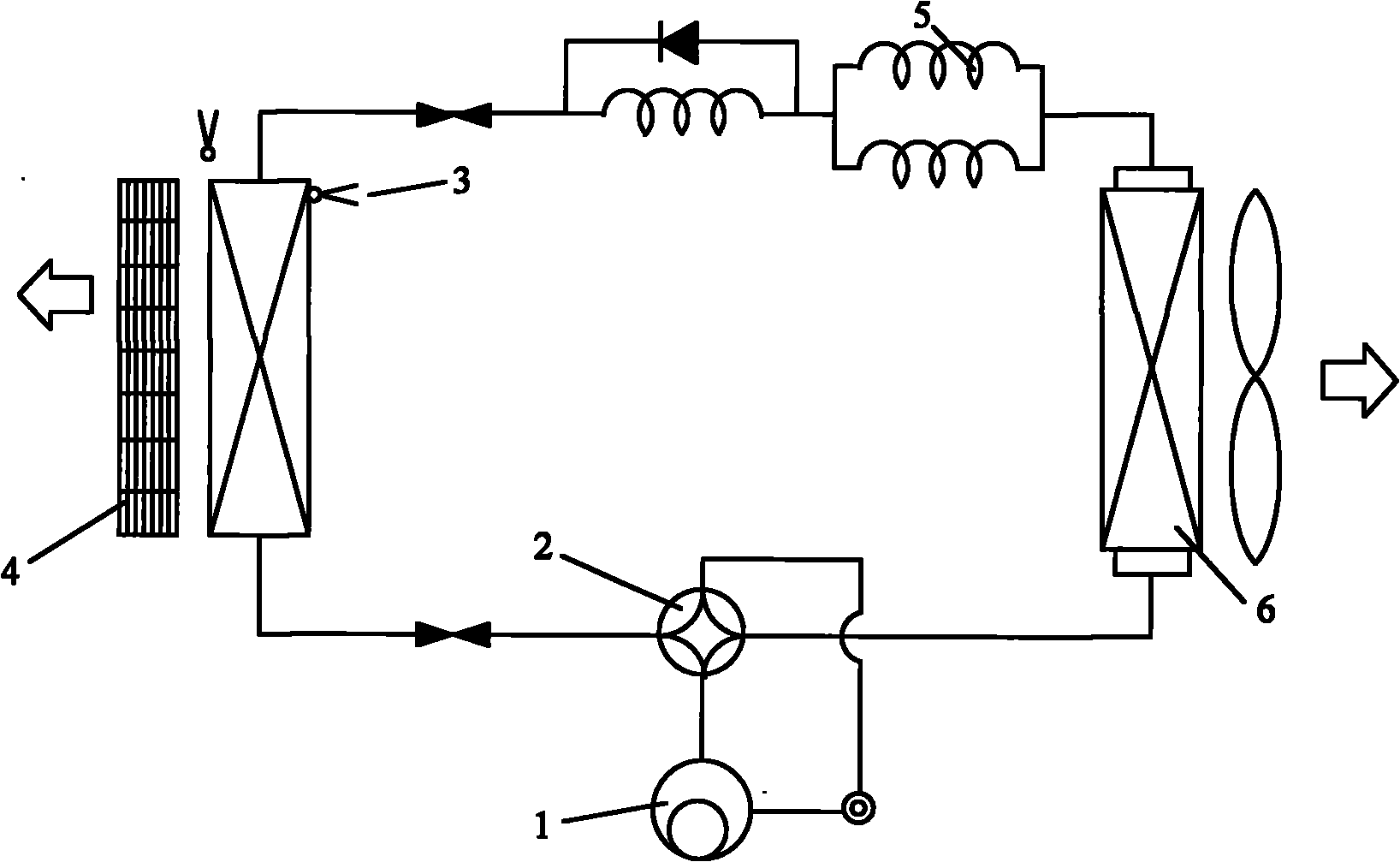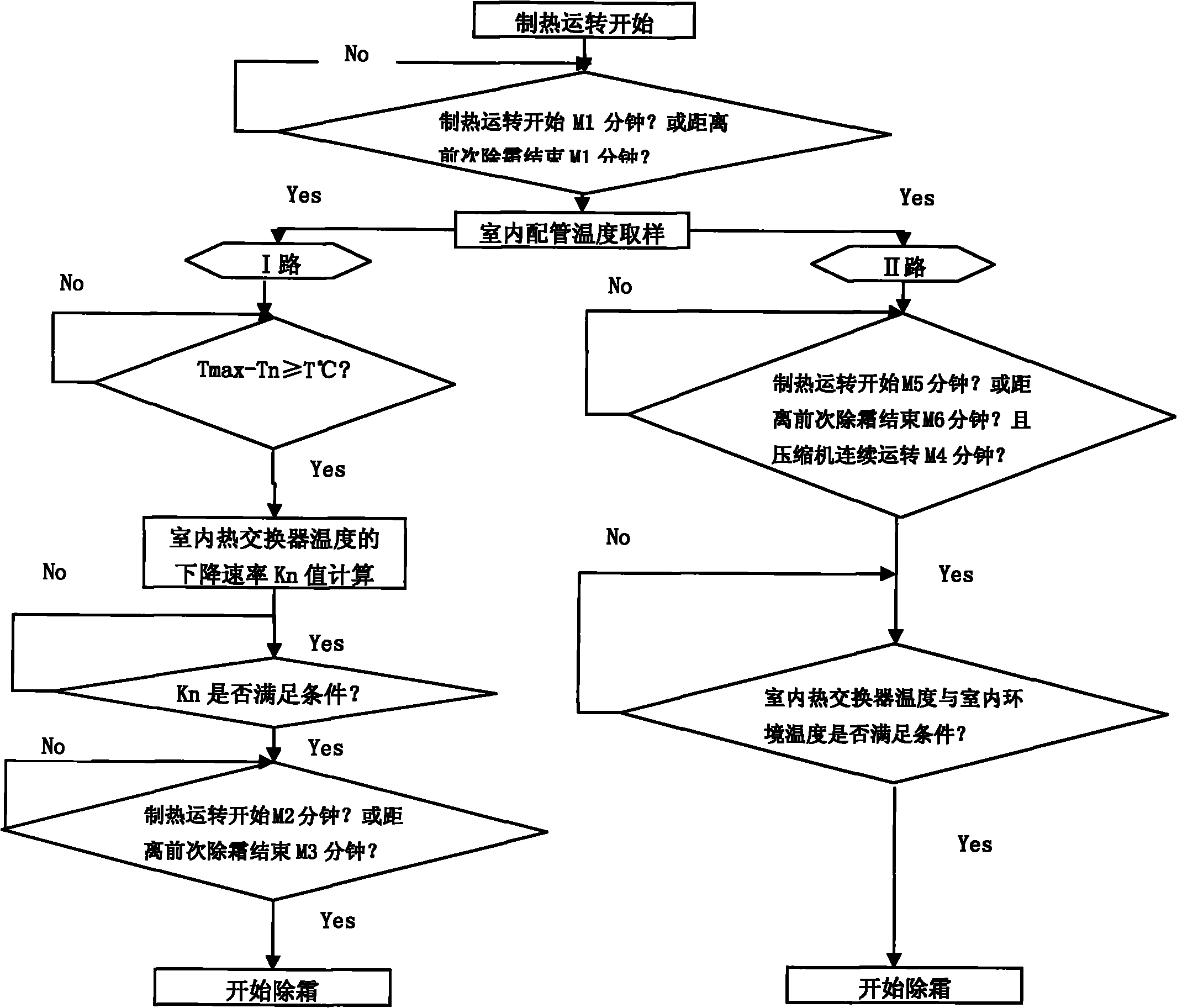Air conditioner defrosting control method and application thereof
A control method and technology for an air conditioner, which are applied in the field of air conditioners, can solve problems such as malfunctions, and achieve the effects of improving efficiency, simplifying circuit structure, and preventing erroneously starting defrosting actions.
- Summary
- Abstract
- Description
- Claims
- Application Information
AI Technical Summary
Problems solved by technology
Method used
Image
Examples
Embodiment 1
[0035] After the set time M1 (M1 is preset to 30 minutes) elapses after the heating mode starts, the temperature sensor continues to sample the temperature of the indoor heat exchanger at a preset interval time S1 (S1 is preset to 10 seconds).
[0036] Record the temperature of the indoor heat exchanger in this operating interval from the first sampling temperature, and record the highest temperature Tmax as 43℃, and then when the current indoor sensor temperature is less than Tmax a set value T℃ (T℃ is preset as 3℃), enter a new timing stage. From this moment on, the time is recorded as t1, t2, t3...tn, and the corresponding temperature is recorded as T1, T2, T3...Tn, and the indoor heat exchanger is calculated. The rate of temperature decrease Kn.
[0037] When Kn is ≥ 0.4 for three consecutive times and the heating operation time M2 reaches 60 minutes, the main controller will issue a defrost start command and enter the defrost operation phase.
Embodiment 2
[0039] After the set time M1 (M1 is preset to 30 minutes) has elapsed after the heating mode starts, the temperature sensor continues to sample the indoor heat exchanger temperature at a preset interval time S1 (S1 is preset to 10 seconds).
[0040] Record the temperature of the indoor heat exchanger in this operating interval from the first sampling temperature, record the highest temperature Tmax as 40℃, and then when the current indoor sensor temperature is less than Tmax a set value T℃ (T℃ is preset as 3℃), enter a new timing stage. From this moment on, the time is recorded as t1, t2, t3...tn, and the corresponding temperature is recorded as T1, T2, T3...Tn, and the indoor heat exchanger is calculated. The rate of temperature decrease Kn.
[0041] When Kn is greater than or equal to 0.25 for three consecutive times, and the set time M3 (M3 is preset to 60 minutes) from the end of the previous defrost is satisfied, the main controller will issue a defrost start command and enter...
Embodiment 3
[0043] After the set time M1 (M1 is preset to 30 minutes) has elapsed after the heating mode starts, the temperature sensor continues to sample the indoor heat exchanger temperature at a preset interval time S1 (S1 is preset to 10 seconds).
[0044] When the heating operation time M5 reaches 60 minutes, and the compressor continues to operate for the set time M4 (M4 is preset to 10 minutes), the indoor fan speed F is 1200 rpm, and the detected indoor ambient temperature Th is 28°C, according to the indoor heat exchanger temperature Tn≤H(35)+D(0.8)*(the indoor ambient temperature Th-20 at this moment)=43.4°C.
[0045] When the temperature of the indoor heat exchanger is lower than 43.4°C for a set time S3 (S3 is preset to 30 seconds), the main controller will issue a defrost start command and enter the defrost operation phase.
PUM
 Login to View More
Login to View More Abstract
Description
Claims
Application Information
 Login to View More
Login to View More - R&D
- Intellectual Property
- Life Sciences
- Materials
- Tech Scout
- Unparalleled Data Quality
- Higher Quality Content
- 60% Fewer Hallucinations
Browse by: Latest US Patents, China's latest patents, Technical Efficacy Thesaurus, Application Domain, Technology Topic, Popular Technical Reports.
© 2025 PatSnap. All rights reserved.Legal|Privacy policy|Modern Slavery Act Transparency Statement|Sitemap|About US| Contact US: help@patsnap.com



